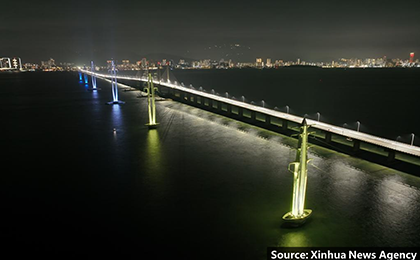



This photo, taken on January 1 in Penang, Malaysia, shows the Penang 275KV Cross-Sea Transmission Line Project constructed by China Harbour Engineering Co., Ltd..
“Five, four, three, two, one... Happy New Year!” At midnight on December 31, 2024, six transmission towers standing in the middle of the Penang Strait, east of Penang Island in Malaysia, lit up one by one to greet the arrival of 2025. These towers, part of the Penang 275KV Cross-Sea Transmission Line Project built by China Harbour Engineering Co., Ltd., participated in the New Year’s Eve lighting ceremony. The illuminated towers formed a majestic outline against the night sky, adding a unique charm to the picturesque Penang Strait.
The project, a collaborative effort between China and Malaysia under the Belt and Road Initiative, spans 8.5 kilometers and is located near the Penang Bridge. It comprises 31 transmission towers, with six iconic twin-leg structures designed in the shape of betel nuts and equipped with landscape lighting, creating a visually distinctive effect.
“As a Penang local, I feel very proud to contribute to the development of my hometown,” said Fang Weiying, Deputy Manager of Design and Technology for the project. “This is Malaysia’s first large-scale cross-sea transmission line, incorporating engineering expertise and technical standards from China. Witnessing this historic moment as an engineer is incredibly meaningful to me.”
Penang is home to Malaysia’s largest electronics industry cluster and boasts over 50 years of development in the electrical and electronics sectors, earning it the nickname “Silicon Valley of the East.” In recent years, rapid population growth and industrial activity have driven up local electricity demand, outpacing the capacity of the existing grid infrastructure. As a critical part of Malaysia’s grid upgrade, the Penang 275KV Cross-Sea Transmission Line Project is expected to optimize the structure and layout of the local grid. Upon commissioning, it is projected to deliver up to 2,000 megawatts of power to Penang Island, significantly enhancing the stability and reliability of electricity supply in the region.
“In less than three years, we completed the project quickly, efficiently, and safely. This collaboration with Chinese enterprises proves that such complex cross-sea engineering projects are not only feasible in Malaysia but can also be delivered efficiently,” remarked Hafizi, a senior Malaysian engineer on the project. Hafizi, fluent in Malay, English, and Mandarin, was responsible for translating Chinese project documents into Malay during the early stages and assisting with obtaining necessary permits. Having witnessed the entire process from groundbreaking to completion, he emphasized that close cooperation between Chinese and Malaysian teams made this project a new landmark in the region.
The project faced significant challenges, including building in “water, high-altitude, and remote” environments. Cross-sea cable installation was a core technical difficulty that relied on a range of innovative technologies. According to Yan Mingjun, the project manager, drone technology was extensively used for the first time to assist with cable stringing, significantly improving efficiency and reducing the risks associated with manual cable installation. The project minimized the need for temporary offshore platforms and traffic diversions, substantially reducing its impact on the surrounding environment and public travel.
Nearby, schools of dolphins often leap out of the water, a sight cherished by local residents. Yan Mingjun explained that the project, spanning both marine and terrestrial areas, prioritized ecological protection. Measures such as anti-pollution chains, safety nets, and comprehensive environmental monitoring helped minimize potential ecological impacts during construction.
“As a "small yet beautiful" livelihood project, it not only ensures stable power supply but also builds an invisible bridge of mutual understanding between China and Malaysia,” said Ma Jianhua, General Manager of China Harbour Engineering’s South Pacific Regional Management Center. Over the past decade, China Harbour has contributed to Penang’s infrastructure development, moving from “connecting roads” to “connecting electricity,” vividly illustrating the fruitful outcomes of China-Malaysia cooperation.
“Through mutual exchange and technical sharing, Chinese and Malaysian enterprises have advanced Malaysia's construction industry and laid a solid foundation for further cooperation,” Hafizi said. “I hope to continue participating in projects built by Chinese enterprises in the future and contribute to Malaysia's development.”